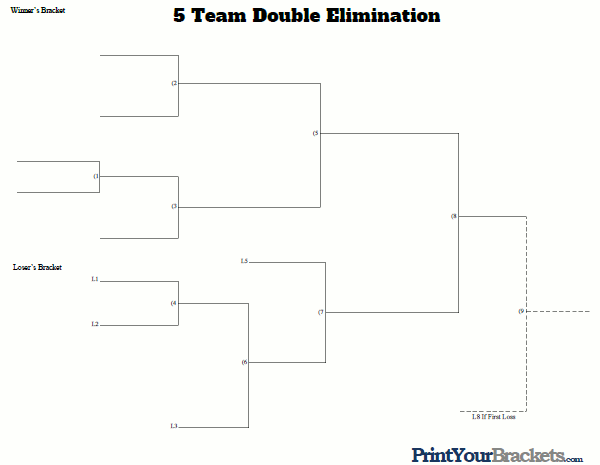In the realm of sports enthusiasm and tournament fever, the bracket takes center stage as a thrilling apparatus that pits teams against each other in a single-elimination showdown. While the classic bracket often accommodates 16 or 32 teams, a unique twist emerges in the realm of 5-team brackets. This tailored format presents a distinct set of dynamics and strategies, inviting enthusiasts to delve into the art of bracket construction with meticulous precision.

Image: ar.inspiredpencil.com
Creating a 5-team bracket may seem like a straightforward task, yet it demands a strategic approach to ensure equitable representation and thrilling matchups. Embark on this guide to master the nuances of 5-team brackets, uncovering the secrets to a well-balanced and captivating tournament experience.
Laying the Foundation: The Anatomy of Team Inclusion
Before venturing into the intricate world of bracket creation, understanding the criteria for team selection is paramount. While personal preferences and competitive dynamics play a crucial role, objectivity and fairness should guide this decision-making process. Consider the following guidelines:
- Team Strength: Assess the relative strengths and weaknesses of the prospective teams, ensuring a balanced spread across the bracket. Avoid placing overly dominant teams in the same quadrant, as this can lead to predictable outcomes.
- Head-to-Head Records: If available, examine previous head-to-head matchups to inform team placement. Favorable head-to-head records can indicate potential advantages that could influence bracket outcomes.
- Recent Form: Consider the teams’ recent performances to gauge their current form. Teams on winning streaks or experiencing a surge in momentum may deserve higher seeds and more favorable bracket positions.
Unveiling the Structure: Single Elimination and Seeding Strategies
5-team brackets typically follow a single-elimination format, meaning that each game is consequential, with losers being eliminated from the competition. This format creates a sense of urgency and excitement, as every matchup carries significant stakes.
To ensure fairness and balance within the bracket, careful seeding is essential. This process involves assigning a numerical rank to each team, which determines their initial placement on the bracket. The top-ranked team is usually placed at the top of the bracket, with lower-ranked teams occupying positions further down.
Determining the seedings can be based on various factors, such as:
- Team Rankings: External rankings or power ratings can provide guidance for seeding. Look for reputable sources that objectively evaluate team strengths.
- Expert Opinions: Seek insights from sports analysts, coaches, or experienced tournament organizers. Their expertise can help inform seedings based on factors that may not be reflected in statistical data.
- Pre-Tournament Scrimmages: If feasible, organize pre-tournament scrimmages or exhibition games to evaluate team matchups and adjust seeding accordingly.
Dissecting the Draw: Balancing Matchups and Drama
The draw phase of bracket creation is where the match pairings are determined. This process requires careful consideration to create compelling matchups while maintaining balance throughout the bracket.
A well-balanced draw ensures that teams with similar strengths face off in the early rounds, gradually progressing towards more competitive matchups as the tournament unfolds. Avoid creating lopsided pairings, as this can lead to predictable and uninteresting games.
To achieve balance, consider the following strategies:
- Odd Numbered Teams: With an odd number of teams, a bye is typically incorporated into the bracket. Strategically allocate the bye to a team that deserves a break or to add an element of suspense to the tournament.
- Cross Seeding: Introduce cross seeding, where teams from different quadrants face off in early rounds. This approach prevents teams from the same side of the bracket meeting prematurely.
- Market Seeding: For events with regional or audience-based considerations, market seeding may be employed. This involves placing teams that are likely to attract larger crowds or generate greater interest in more prominent positions on the bracket.

Image: www.printyourbrackets.com
Embracing the Digital Age: Technology and Bracket Tools
In the digital age, numerous online tools have emerged to streamline the process of creating brackets. These tools offer user-friendly interfaces and customizable settings that cater to various tournament formats and needs. Some notable bracket-generating platforms include:
- Challonge: A popular platform with features such as automatic pairings, customizable designs, and integration with social media.
- Bracket Maker: An intuitive tool that allows for easy bracket creation, sharing, and printing.
- Google Sheets: Utilizing Google Sheets can be a practical option for basic bracket generation and collaboration.
Choosing the appropriate tool depends on the specific requirements and preferences of the tournament organizer. These tools can save valuable time and effort while ensuring accuracy and consistency in bracket creation.
How To Make A 5 Team Bracket
In Conclusion: An Art of Balance and Excitement
Mastering the art of creating 5-team brackets requires a meticulous approach, balancing team dynamics, seeding strategies, and the thrill of balanced matchups. By thoughtfully implementing the principles outlined in this guide, tournament organizers can craft brackets that ignite fierce competition and keep spectators captivated from the opening tip-off to the final buzzer.
Remember to approach bracket creation with a spirit of fairness, creativity, and a deep understanding of the teams involved. Embrace the power of technology to enhance the process while maintaining the integrity and excitement that define the world of sports tournaments.







